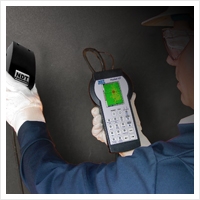 Traditional Ultrasonic inspection uses high frequency sound energy to conduct examinations and perform measurements. Considerable information may be gathered during ultrasonic testing such as the presence of discontinuities, material or coating thickness. The detection and location of discontinuities is enabled by the interpretation of ultrasonic wave reflections generated by a transducer. These waves are introduced into a material and travel in a straight line and at a constant speed until they encounter a surface. The surface interface causes some of the wave energy to be reflected and the rest of it to be transmitted. The amount of reflected vs. transmitted energy is detected and provides information on the size of the reflector, and therefore the discontinuity encountered.
Traditional Ultrasonic inspection uses high frequency sound energy to conduct examinations and perform measurements. Considerable information may be gathered during ultrasonic testing such as the presence of discontinuities, material or coating thickness. The detection and location of discontinuities is enabled by the interpretation of ultrasonic wave reflections generated by a transducer. These waves are introduced into a material and travel in a straight line and at a constant speed until they encounter a surface. The surface interface causes some of the wave energy to be reflected and the rest of it to be transmitted. The amount of reflected vs. transmitted energy is detected and provides information on the size of the reflector, and therefore the discontinuity encountered.
Three basic ultrasonic techniques are commonly used:
Normal/Angle Beam – Normal beam testing uses a sound beam that is introduced at 90 degrees to the surface – for thickness testing, while angle beam utilizes a beam that is introduced into the specimen at some angle other than 90 degrees – for defect location. The choice between the two is made based on the orientation of the feature of interest so that the sound may produce the largest reflection from the feature and obstructions on the surface of the specimen that must be avoided.
Some of the most common Ultrasonic applications are:
Flaw detection (cracks, inclusions, porosity, delaminating etc.)
Erosion/Corrosion thickness gauging Info from ultrasonic inspection can be presented in a number of formats: A-Scan displays the amount of received ultrasonic energy as a function of time Be-Scan displays a profile view (cross-sectional) of a specimen
C-Scan displays a plan type view of the specimen and discontinuities Hybrid/Stitched displays a C-Scan plan view with A and/or B Scan views along with C-Scan views that have been woven together to illustrate a clearer picture of the damaged areas of a specimen. The stitched views are used for larger specimens and surface areas.
Some of the major advantages of ultrasonic testing are:
Detects surface and subsurface defects Depth of penetration vs. other test methods is superior Only single sided access is required with a pulse-echo technique High accuracy regarding estimating discontinuity size and shape Minimal specimen preparation is required Instantaneous results produced by using electronic equipment Detailed images can be produced with automated systems.
Major limitations of ultrasonic testing are:
Surface must be accessible. Skill training is more extensive than with some other methods for personnel. Normally requires couplant to promote sound transfer. Surface roughness, complex geometries, small parts or exceptionally thin materials are difficult to inspect. Coarse grained material ie. Cast iron is difficult to inspect due to low sound transmission and high signal noise. Linear defects oriented parallel to the sound beam go undetected. Reference standards are required for equipment calibration for each item tested.
